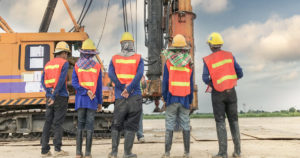
Asbestos is inexpensive, durable, and heat and fire-resistant, making it particularly useful on a construction site. Asbestos was used for insulation of walls and high-heat metal structures; as an additive in paint, plasters, and cement; and as a component of floor tiles, roof shingles, and drywall products. The construction boom that began in the 1920s featured heavy use of asbestos; by the 1960s, however, the correlation between asbestos and serious respiratory illnesses was firmly established, and asbestos products were largely phased out in the later part of the century. However, many buildings still have asbestos features and construction workers who are maintaining, demolishing, or remodeling these buildings have a high risk of coming into contact with asbestos.
Which Construction Workers are Most At-Risk?
Asbestos is most dangerous when it is airborne. Disturbing asbestos fibers can cause the tiny particles to float away, putting everyone on a work site at risk of inhaling or ingesting them. Although all construction workers are in danger of asbestos exposure, the risk is higher for certain workers who are more likely to interact with asbestos products regularly. Workers handling drywall and drywall tape may create asbestos dust when cutting it. Likewise, masons and bricklayers must cut and sand bricks, stones, or mortars, all of which may contain asbestos. Roofers and tile setters encounter asbestos not just in the tiles and shingles themselves, but also in grout and adhesives. Paints and spackles containing asbestos also put painters at risk. Numerous studies have reported exponentially higher asbestos concentrations in the air during these activities.
Although asbestos has been widely banned, there are still some construction materials that can contain asbestos if they meet certain guidelines. This, combined with the fact that asbestos still exists in buildings constructed before the 1970s, makes the risk of asbestos exposure a constant for today’s construction workers. Approximately one million construction workers are exposed to asbestos products each year. Asbestos-related diseases have a long latency period, meaning that retired construction workers who have not encountered asbestos in years may start experiencing symptoms now. Even family members of construction workers face an increased risk, as workers may have carried asbestos fibers home on clothes and in their cars for years.
Philadelphia Asbestos Lawyers at Shein Law Help Construction Workers Diagnosed with Mesothelioma
If you or a loved one has been diagnosed with mesothelioma or another asbestos-related disease, contact the Philadelphia asbestos lawyers at Shein Law. Our legal team will thoroughly review the facts of your case to determine who is at fault for your asbestos exposure and hold them accountable. We are committed to helping construction workers and their families obtain the compensation to which they are entitled. Call us today at 877-743-4652 or contact us online for an initial consultation. With offices in Philadelphia and Pennsauken, New Jersey, we proudly help asbestos exposure victims throughout Pennsylvania and New Jersey.
